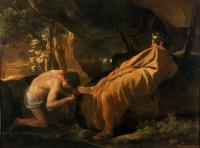Friday, May 18, 2012 -  Laviano,Napoli,Peter Watson,Sicily,The Caravaggio Conspiracy,The Palermo Nativity
Laviano,Napoli,Peter Watson,Sicily,The Caravaggio Conspiracy,The Palermo Nativity
 No comments
No comments
 Laviano,Napoli,Peter Watson,Sicily,The Caravaggio Conspiracy,The Palermo Nativity
Laviano,Napoli,Peter Watson,Sicily,The Caravaggio Conspiracy,The Palermo Nativity
 No comments
No comments
REVISITING BOOKS: An Earthquake Shatters Expectations in The Caravaggio Conspiracy
by Catherine Schofield Sezgin, ARCA blog editor
Peter Watson writes in The Caravaggio Conspiracy that in 1980 when he was trying to negotiate the purchase of Caravaggio's Palermo Nativity that going to southern Italy with a 'briefcase full of cash' was considered dangerous. Watson wrote:
This was the time in Italy when kidnapping was increasing alarmingly. In fact the risk of kidnap was so great that even going to Naples simply as a businessman was not without danger. The proportion of foreign visitors to the city had slumped from 50 percent of hotel business to less than 10 percent. Furthermore, a report had shown that murders by the Mafia at that time accounted for 29 percent of all killings, as opposed to 13 percent a decade before.
Watson was offered the painting in London by a member of the gang art detective Rodolfo Siviero had suspected of stealing the Palermo Nativity. Watson received a phone call from Italy that he could have the Caravaggio painting for 150 million Italian lire or $150,000 American dollars. The journalist booked three nights at the Excelsior in Naples to conduct the transaction.
In nearby Laviano, Watson was presented with two photographs of the painting:
It looked terrible. It was very dark, darker than I had imagined it could look. Bits appeared to have flaked off near the heads of the onlookers on the right of the painting and there was a patch, of damp or oil or whatever, in the right foreground covering the ankle and hand of St. Lawrence. Worst of all there was a ragged crack, about a third of the way up, bisecting the Virgin's hands and penetrating St. Lawrence's shoulder. That seemed consonant with the canvas having been rolled for some time, possibly immediately after it had been stolen.
Watson is told that the painting is in Sicily but that it can be brought to Naples in a few days. Then a deadly and destructive earthquake leveled Laviano. Watson was unable to contact with his negotiators and any hope of purchasing the stolen painting vanished.









